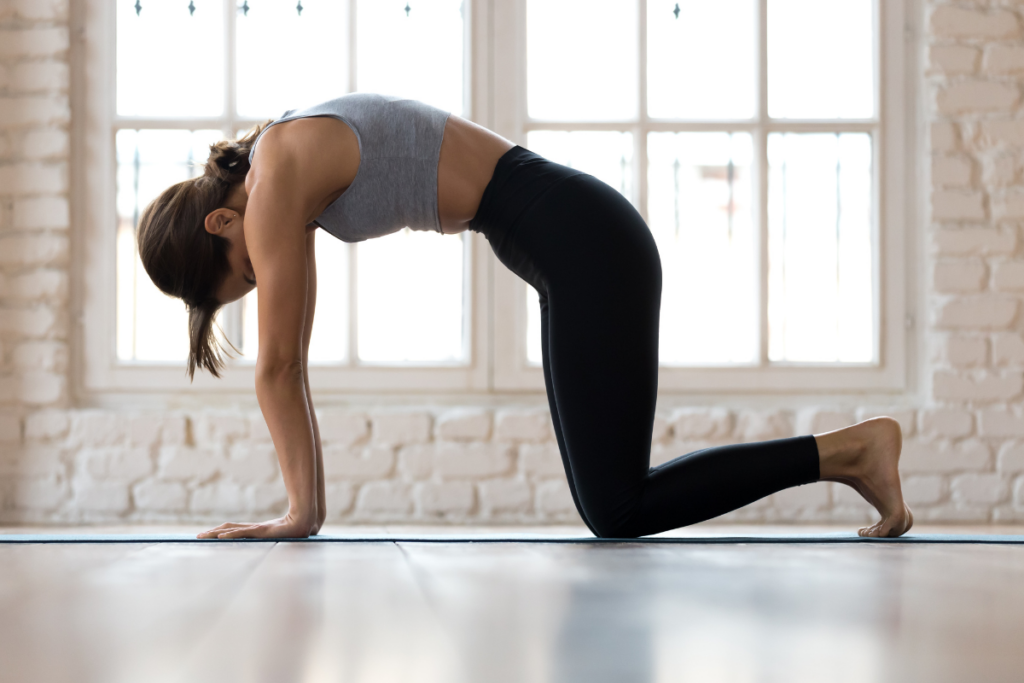Over 16 million Americans experience back pain — and did you know that your posture can transform your health and help you feel more comfortable as you navigate the day. But even if you know you want to improve your posture, it’s not exactly obvious what changes to make. We’ve compiled this guide filled with tips and tricks for maintaining proper posture.
The Importance of Maintaining Proper Posture
When you have good posture, you hold your body in a way that correctly aligns your head, shoulders, and hips. Here are just a few key benefits of maintaining great posture:
- Good posture can reduce the risk of having chronic muscle, neck, and back pain.
- When you feel good about how you carry yourself, you can appear more confident.
- Regulating your posture can promote body awareness — and it’s always good to be in tune with what your body experiences!
The impact of poor posture on health
On the flip side, if your posture isn’t the best, you can experience adverse effects:
- When you don’t have good posture, you can experience poor circulation.
- You’ll likely experience frequent back and neck pain if your spine isn’t properly aligned.
- Poor posture can even affect your digestive system.
Maintaining proper posture can improve your day-to-day life and reduce your risk of encountering significant health problems further down the road.
Identifying Common Posture Problems
Recognizing signs of poor posture is important in making lasting, positive changes. Understanding the basics of proper posture and common signs of bad posture can help you form a plan to correct your course.
The basics of good posture
Good posture involves keeping your body balanced and aligned. It involves maintaining a natural curve in your spine, relaxing your shoulders, and distributing your weight evenly. Whether you’re sitting, standing, or walking, it’s essential to keep your head, neck, and shoulders in a comfortable and straight position.
What contributes to poor posture
Poor posture often stems from habits and lifestyle choices that strain your body — especially your spine. How you move throughout the day, from how you sit, stand, carry things, and how you sleep, can all contribute to your posture. Weak muscles, especially in the core and back, can also play a role, as they may struggle to support the body properly. Working a desk job that involves long intervals of sitting can also contribute to poor posture. In some cases, health conditions or injuries may also impact posture. But overall, poor posture usually stems from a lack of awareness — if you make it your mission to be more aware of your body, you can improve your posture over time.

Posture-Friendly Workspaces and Ergonomics
Good posture is vital for keeping healthy. It’s important to and should be supported when seated. That’s where ergonomics come into play. Ergonomics is a relatively new study that focuses on understanding the best ways to set up things like chairs, desks, and tools to make it comfortable and easy for people to work. With the correct setup, you can minimize discomfort and maintain proper posture.
Desk and chair setup
The right desk and chair setup is essential for maintaining a good posture. A desk that’s 28 inches tall generally allows your feet to rest flat on the floor with your knees bent at ninety degrees and your forearms level with the ground while typing away. As you work, try to sit back in your seat with both feet flat on the ground and keep your spine straight. If you can’t comfortably rest your feet on the ground, consider using a footrest.
Proper use of technology
Most desk jobs involve using some kind of technology — but did you know that where your computer or monitor is positioned makes a huge difference in your posture? For instance, try to ensure the top third of your monitor aligns with your forehead or position it at eye level to reduce neck strain when looking at a screen. When talking on the phone, hold your phone up near your face instead of pinching it between ear and shoulder for minimal stress on shoulders, arms, and neck. It is important to thoughtfully position your keyboard and mouse to avoid unnecessary pressure on your wrists, arms, fingers, etc. And most importantly, take regular breaks from tech and avoid sitting for long periods of time.
Exercises and Stretches to Improve Your Posture
By doing regular exercises and stretches, you can improve your posture over time. Here are a few basic exercises that don’t require equipment to incorporate into your workout:
- Plank: Begin in a push-up position with your arms straight beneath your shoulders. Tighten your core muscles, keep your body straight, and hold the position for 20-30 seconds. Gradually increase the duration of your plank as you become stronger.
- Shoulder Blade Squeeze: Sit or stand with your back straight. Gently squeeze your shoulder blades together — this might not feel comfortable, but try to squeeze as tight as possible. Hold for 5-10 seconds, then release. Repeat 10-15 times.
- Bridge Exercise: Lie on your back with your knees bent and your feet flat on the floor. Lift your hips and buttocks toward the ceiling, creating a straight line from your shoulders to your knees. Hold briefly, then lower your hips while engaging your core muscles. Repeat 10-12 times.
Stretching is also beneficial and yields health benefits beyond just improving your posture. Whether you’re already a huge fan of stretching and yoga or you’re new to the practice, concentrating on posture-specific stretches can make a big difference in how you feel. Try doing these every day — it will only take about five or ten minutes!
- Cow-Cat Stretch: Start on your hands and knees in a tabletop position. Inhale, arching your back (cow pose), and then exhale, rounding your back (cat pose). Repeat this fluid motion 10-12 times to promote flexibility and spine alignment.
- Neck Tilt: Sit or stand with your back straight. Slowly tilt your head to one side, rotating your neck until your ear points toward your shoulder. You should feel a gentle pull on the opposite side of your neck. Hold for 15-20 seconds, then switch sides.
- Child’s Pose: Kneel on the floor, lean back on your heels, and reach your arms toward the ground. With your arms extended, lower your torso so your hands point toward the floor. Hold for 20-30 seconds, feeling a stretch in your back and shoulders.

Everyday Habits for Better Posture
You can improve your posture just by making small changes in daily habits. We’ll break down a few tips for improving your posture in your everyday life.
Proper sitting and standing techniques
Positioning your body correctly while sitting and standing can highly impact your posture.
- Keep your spine straight when seated, allowing arms to rest on armrests with elbows close by the sides of the body.
- Your shoulders should be relaxed and your feet firmly placed flatly under your knees.
- When standing up, weight distribution must happen evenly throughout both feet, making sure your feet are aligned correctly with your kneecaps.
- Your head should stay in line with your shoulders at all times, with your chin tucked slightly towards your chest.
Throughout the day, try to do a posture check — think about how you’re holding your body, and correct as needed.
Taking frequent breaks and staying active
It is essential to have frequent breaks and stay active throughout the day to counterbalance posture-related issues, especially if you work a desk job. Prolonged sitting can lead to tightened or weakened muscles and ligaments, eventually leading to poor posture. Try to incorporate movement every half-hour: some activities can even be performed right at your desk, like rolling your shoulders, gently stretching your arms, and rotating your wrists.
What about Posture Correctors?
You can consider using a posture corrector to align the spine and quickly improve your posture. Various types of products are widely available, including shoulder braces, back supports, and even special shirts that provide support when wearing them. It is essential to wear these devices in regular intervals for no more than 30 minutes each time during different times throughout the day so that muscles learn how to stay in position without help over time.
When wearing any support gear, don’t overdo it at first: start small by putting the item on for around half an hour daily for some days to get used to it. Always be sure that all straps fit snugly but comfortably according to the instructions given by the manufacturer or your provider before adjusting them as needed.
Wearing a posture corrector for several hours daily can help improve your posture and strengthen your muscles. Despite initial discomfort or irritation, consistent use of correctors can effectively rebalance muscle imbalances. If you’re considering using a posture corrector, it’s a good idea to check with a provider like your primary care physician or a chiropractor to ensure it’s the right fit for you.
Experiencing Chronic Pain? We’re Here to Help.
If you’re in chronic pain, improving your posture may help — but if you’d like to address your posture concerns with a provider, Community Access Network is here for you. Our compassionate staff would love to hear your concerns and come up with a plan to help prevent pain and improve your overall well-being.
